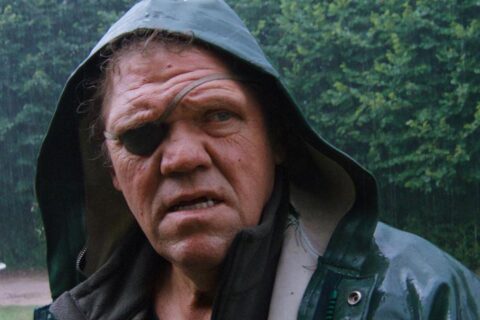A long-lost French twin to John C. Reilly, Raphaël (Raphaël Thiéry) is certainly not a conventionally attractive man. He is overweight, his face is lined with crags and nooks and he only has one eye. Living alone with his mother Lucienne (Mireille Pitot) in an almost abandoned Italianate mansion, with high arches, endless rooms and a huge courtyard, the 58-year-old spices up his job as a caretaker by blowing up moles, playing the bagpipes and carrying on a loveless affair with his local postwoman (Marie-Christine Orry).
One gets the sense that there isn’t much more to Raphaël’s life than this. Certainly not any genuine romance. I have to admit that I was worried in the first act that I was merely watching a collection of quirks as opposed to a genuinely fleshed-out vision. I shouldn’t have worried. In the tender, slow, yet purposeful atmosphere created in Anaïs Tellenne’s excellent debut The Dreamer (2023), ideals, art and self-expression can be formed out of almost nothing.
An early, potent symbol comes from Lucienne receiving a small Golem from Prague. An image from Jewish folklore, it is an anthropomorphic being shaped out of clay. One of the most flexible metaphorical figures from any religion, a Golem can mean almost anything. The rest of the film tests this theory, using the power of imagination to give its protagonist a seemingly limitless potential, even within the boundaries of his own body.
Arriving the same evening as this noticeable shelf ornament is a famous performance artist, and heiress to the mansion, named Garance (Emmanuelle Devos). Seemingly modelled after Marina Abramović, her work is deeply inspired by her own life; for example, one installation is just a collection of her own tears (70 after a divorce; 120 when moving house). One of her first moves is to remove all the stuffy portraits of previous owners, replacing them with her more contemporary, interesting work.
Raphaël is instantly intrigued by her. They strike up a strange acquaintance. She sees something potent in his body that she wants to unlock. She offers to sculpt him. With shades of La Belle Noiseuse (Jacques Rivette, 1991), particularly in that knotty relationship between artist and muse, their interplay isn’t particularly erotic or romantic. It feels deeper than mere sexual dynamics. You get a sense, rather movingly, that no one has ever looked at him quite like that.
The sculpture in its infancy often resembles The Thing from the Fantastic Four comics, all rutted edges and an odd, flat head, but as time progresses, it becomes more and more beautiful, capturing the essence of Raphaël, imploring the viewer to look beyond baseline assumptions. Credit must go to Thiéry himself. His Raphaël is not a talkative, philosophical man, but he is able to take us through this emotional journey through a variety of powerful facial expressions — just as if he is posing for various sculptures himself.
Enhancing the sultry, suggestive atmosphere is Amaury Chabauty’s mysterious score, with rising oboe lines, harp arpeggios and occasional high-singing voices. Despite some of the soundtrack veering a little too close to the English folk song “Greensleeves”, it fits within the film’s Celtic atmosphere, imbuing it with the simplicity of an old-timey ballad. Complementing the music rather well, cinematographer Pierre W. Mazoyer crafts middle-distance, grainy tableaus of the overcast, wet, yet luscious mansion. Avoiding flashy movements or style for the sake of it, there is a purity to both image and sound, whisking you along Raphaël’s heartwarming journey.
But beyond my hitherto feel-good description is another layer, one of complication and confusion; the question as to whether Garance genuinely feels an attachment to Raphaël or if she is merely using him to win more critical acclaim. Enigmatically skirting around the question as opposed to settling on any easy answers, Tellenne’s debut hits that bittersweet sweet spot many battle-hardened directors never reach.

Redmond is the editor-in-chief of Journey Into Cinema.
